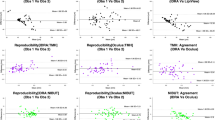Abstract
Background
Some studies report that increased tear osmolarity is a reliable indicator of dry eye syndrome (DES). The OcuSense TearLab™ osmometer requires less than a 100-nl sample of tears and provides an instant quantitative result. Our aim was to clinically evaluate this instrument in terms of its reproducibility and repeatability.
Methods
Twenty-nine participants who ranged in age from 19 to 49 years (mean ± SD: 23.3 ± 5.5 years) were recruited. Osmolarity readings were collected by two operators, in two sessions separated by 1 or 2 weeks in order to assess test reproducibility and repeatability.
Results
The coefficient of reproducibility was 39 mOsms/l; the coefficient of repeatability was 33 mOsms/l.
Conclusions
Our mean coefficient of variation over four readings for 29 subjects is 2.9%, which compares well with that reported by the manufacturer. Our results inform practitioners about the level of change over time that can be considered clinically relevant for healthy subjects. This value is 33mOsms/l; any change smaller than this could be attributed to measurement noise.


Similar content being viewed by others
References
Srinivasan S, Nichols K (2009) Collecting tear osmolarity measurements in the diagnosis of dry eye. Expert Rev Ophthalmol 4:451–453
Mathers W (2000) Why the eye becomes dry: a cornea and lacrimal gland feedback model. CLAO J 26:159–165
Nelson J, Wright J (1986) Tear film osmolarity determination: an evaluation of potential errors in measurements. Cur Eye Res 5:677–681
Pensyl C, Benjamin W (1999) Vapor pressure osmometry: minimum sample microvolumes. Acta Ophthalmol Scand 77:27–30
Bron A (2001) Diagnosis of dry eye. Surv Ophthalmol 45:S221–S226
Sullivan B (2005) Clinical resorts of a first-generation lab-on-chip nanolitre tear film osmometer. Ocul Surf 3:S31
Benelli U, Nardi M, Posarelli C, Albert T (2010) Tear osmolarity measurement using the TearlabTM Osmolarity System in the assessment of dry eye treatment effectiveness. Con Lens Anterior Eye 33:61–67
Pederson-Bjergaard K, Smidt B (1952) Electrolytic conductivity, osmotic pressure, and hydrogenion concentration of human lachrymal fluid. Acta Derm Venereol Suppl (Stockh) 32:261–267
OcuSense Inc. (2008) TearLab Osmolarity test Card: Instructions for use
Uniacke N, Hill R (1970) Osmotic pressure of the tears during adaptation to contact lenses. J Am Optom Assoc 41:932–936
Gilbard J, Farris R, Santamaria J (1978) Osmolarity of tear microvolumes in keratoconjunctivitis sicca. Arch Ophthalmol 96:677–681
Bland J, Altman D (1986) Statistical methods for assessing agreement between two methods of clinical measurement. Lancet 1:307–310
Chen S, Chandna A, Norcia A, Pettet M, Stone D (2006) The repeatability of best corrected acuity in normal and amblyopic children 4 to 12 years of age. Invest Ophthalmol Vis Sci 47:614–619
Fortes MB, Diment BC, Di Felice U, Gunn AE, Kendall JL, Esmaeelpour M, Walsh NP (2011) Tear Fluid Osmolarity as a Potential Marker of Hydration Status. Med Sci Sport Exerc 43:1590-1597
Tomlinson A, McCann LC, Pearce EI (2010) Comparison of Human Tear Film Osmolarity Measured by Electrical Impedance and Freezing Point Depression Techniques. Cornea 29:1036–1041
Utine CA, Bicakcigil M, Yavuz S, Ciftci F (2011) Tear Osmolarity Measurements in Dry Eye Related to Primary Sjögren’s Syndrome. Curr Eye Res 36:683–690
Versura P, Profazio V, Campos EC (2010) Performance of Tear Osmolarity Compared to Previous Diagnostic Tests for Dry Eye Diseases. Curr Eye Res 35:553–564
Khanal S, Millar T (2011) Barriers to clinical uptake of tear osmolarity measurements. Br J Ophthalmol. doi:10.1136/bjo.2011.202754
Messmer E, Bulgen M, Kampik A (2010) Hyperosmolarity of the tear film in dry eye syndrome. Dev Ophthalmol 45:129–138
Acknowledgements
The authors declare no conflicts of interest.
Authorship
All named authors were involved in the conception and design of the study, interpretation of data, and revising it critically for important intellectual content. MA, HB and FE were involved with the data analysis. All named authors gave final approval of the version to be published. MA collected the data. HB, MA and FE drafted the article. FE provided training with data collection.
Author information
Authors and Affiliations
Corresponding author
Rights and permissions
About this article
Cite this article
Eperjesi, F., Aujla, M. & Bartlett, H. Reproducibility and repeatability of the OcuSense TearLab™ osmometer. Graefes Arch Clin Exp Ophthalmol 250, 1201–1205 (2012). https://doi.org/10.1007/s00417-012-1961-4
Received:
Revised:
Accepted:
Published:
Issue Date:
DOI: https://doi.org/10.1007/s00417-012-1961-4




